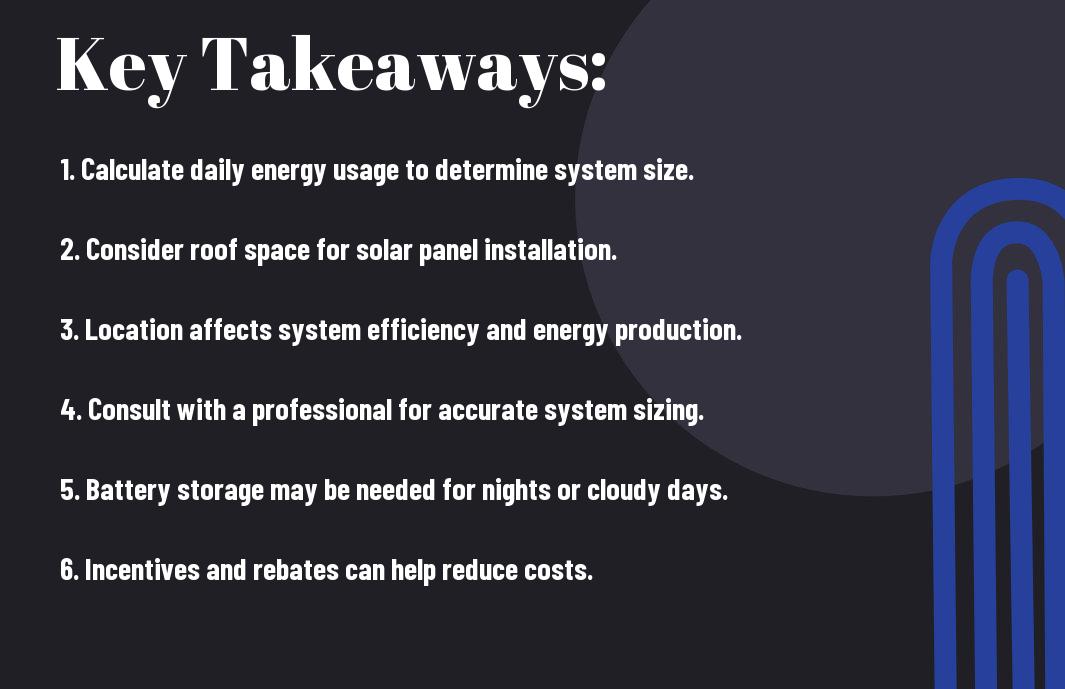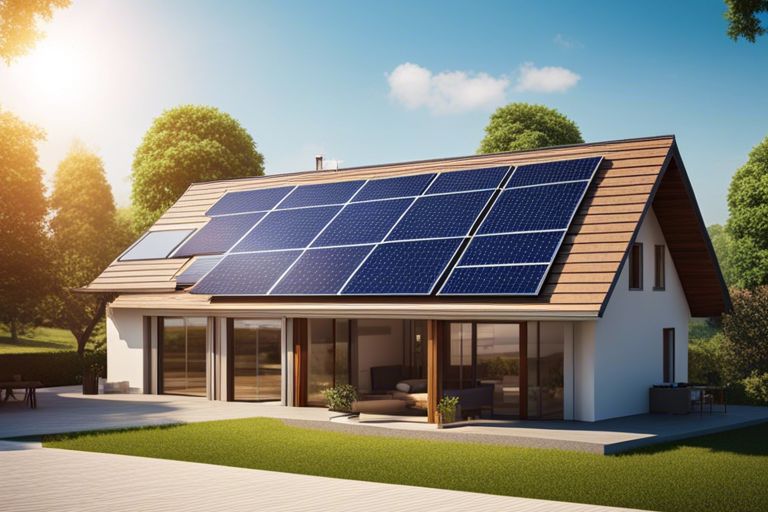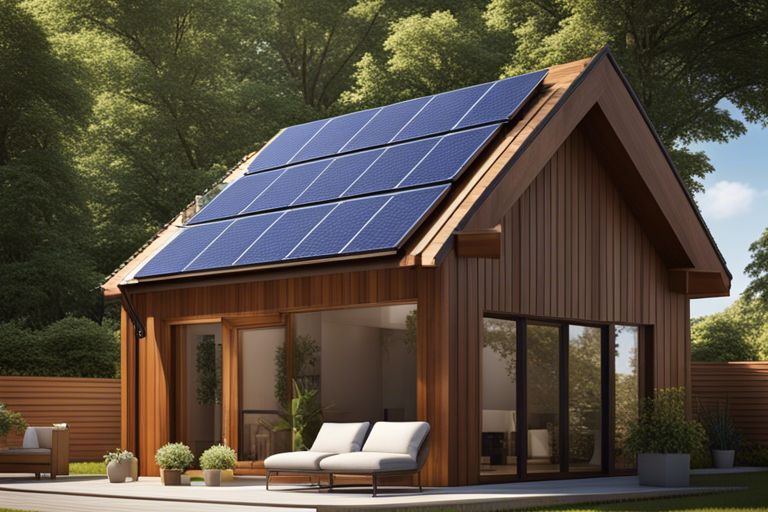Most homeowners are curious about the size of a solar system needed to power their house efficiently. In this informative guide, you will learn about the factors that determine the size of the solar system required to meet your energy needs. Understanding your power consumption habits and the availability of sunlight in your area are crucial in determining the right solar setup for your home. Let’s explore the world of solar energy together.
Key Takeaways:
- Assess Your Energy Needs: Calculate your average daily energy consumption to determine the size of the solar system needed.
- Consider Sunlight Availability: Ensure your location receives adequate sunlight throughout the day to maximize solar power generation.
- Consult with Professionals: Consult with solar energy experts to accurately size and install a solar system that meets your specific energy requirements.

Determining Your Energy Needs
Calculating Your Daily Energy Consumption
Your first step in determining how big of a solar system you need to run your house is to calculate your daily energy consumption. This involves looking at your electricity bills over the past year and determining the average kilowatt-hours (kWh) you use per day. You can also use energy monitoring devices to track your usage more accurately.
Factors Affecting Energy Requirements
- The size of your household and the number of people living in it
- The climate and average amount of sunlight in your location
- The energy efficiency of your appliances and electronics
Your home’s energy requirements are influenced by various factors. The size of your household and the number of people living in it will affect how much energy you consume on a daily basis. Additionally, the climate and average amount of sunlight in your location will determine how much solar energy you can harness. The energy efficiency of your appliances and electronics will also play a significant role in your overall energy needs.
- evaluating these factors, you can get a better idea of how much energy your household consumes and how much solar power you would need to generate to meet your needs.
Energy efficiency plays a crucial role in determining the size of the solar system you need. By investing in energy-efficient appliances and making efforts to reduce your overall energy consumption, you can potentially decrease the size of the solar system required to run your house efficiently.
Sizing Your Solar System
While the idea of harnessing solar energy for your home is exciting, determining the size of the solar system you’ll need can be a daunting task. To accurately size your solar system, you need to consider several factors specific to your location and energy consumption.
Measuring Your Roof’s Solar Potential
With advancements in solar technology, calculating your roof’s solar potential has become easier than ever. Tools such as Google’s Project Sunroof can provide you with detailed information on how much sunlight your roof receives throughout the year. By inputting your address, you can access estimates on the ideal system size for your home.
Considering Shading and Obstructions
Considering potential shading and obstructions is crucial when determining the size of your solar system. Trees, nearby buildings, and even chimneys can block sunlight from reaching your solar panels, reducing their efficiency. It’s important to assess any factors that may cast shadows on your roof throughout the day to ensure optimal solar energy production.
Solar panels work best when they receive direct sunlight for the majority of the day. Even partial shading can significantly impact the output of your system and should be taken into account when sizing your solar setup.

Types of Solar Panels
For your solar system, it’s crucial to understand the different types of solar panels available on the market. The type of solar panel you choose will impact the efficiency and cost of your system. Here are the main types of solar panels:
| Monocrystalline Panels | Polycrystalline Panels |
| Thin-Film Panels | Amorphous Silicon Panels |
| Cadmium Telluride (CdTe) Panels | Copper Indium Gallium Selenide (CIGS) Panels |
Monocrystalline vs. Polycrystalline Panels
The choice between monocrystalline and polycrystalline panels often comes down to efficiency versus cost. Monocrystalline panels are made from single-crystal silicon and are known for their higher efficiency rates. On the other hand, polycrystalline panels are made from multiple silicon crystals, making them less efficient but more cost-effective. When deciding between the two, consider your budget and space constraints.
Thin-Film Solar Cells
Any discussion about solar panels would be incomplete without mentioning thin-film solar cells. These panels are lightweight, flexible, and easier to install compared to traditional panels. Thin-film solar cells are typically made from materials like cadmium telluride (CdTe) or copper indium gallium selenide (CIGS). They are less efficient than crystalline silicon panels but can be a great option for certain applications.
It is important to note that thin-film solar cells are more suitable for large-scale installations or situations where traditional panels may not be practical. If you have limited roof space or need a more flexible installation option, thin-film solar cells could be the way to go.

Inverters and Charge Controllers
All solar power systems need inverters to convert the DC electricity produced by the solar panels into AC electricity that is used in your home. There are two main types of inverters to consider: string inverters and microinverters. String inverters are the more traditional option, where several solar panels are connected in series to a single inverter. On the other hand, microinverters are attached to each individual solar panel, allowing for optimization of each panel’s performance.
String Inverters vs. Microinverters
Inverters play a crucial role in the efficiency and performance of your solar power system. With string inverters, the performance of all panels is dependent on the output of the lowest-performing panel in the string. In contrast, microinverters can optimize the output of each individual panel, which can be beneficial if your panels are subject to shading or varying sunlight throughout the day.
Charge Controllers for Battery-Based Systems
On battery-based solar power systems, charge controllers are crucial to regulate the flow of electricity between the solar panels and the batteries. These controllers prevent overcharging, which can damage your batteries and reduce their lifespan. They also help ensure a consistent flow of electricity to your batteries, optimizing their performance and efficiency.
Charge controllers come in two main types: PWM (Pulse Width Modulation) and MPPT (Maximum Power Point Tracking). MPPT controllers are more advanced and efficient, as they can adjust the voltage and current to maximize the power output of your solar panels. When choosing a charge controller for your battery-based system, opt for an MPPT controller for improved energy harvest and overall system performance.
Battery Backup and Energy Storage
Now, let’s talk about the importance of battery backup and energy storage in a solar system. One of the key components of a reliable off-grid solar system is a deep cycle battery. These batteries are designed to be charged and discharged repeatedly, making them perfect for storing energy generated by your solar panels.
Deep Cycle Batteries for Solar Systems
Backup when the sun is not shining, such as during the night or on cloudy days, the stored energy in your deep cycle batteries can power your home. It is important to choose high-quality deep cycle batteries that are compatible with your solar system to ensure optimal performance and longevity.
Sizing Your Battery Bank
Backup when determining the size of your battery bank, you need to consider your daily energy usage, the number of days of autonomy you want (how many days you can go without sunlight), and the efficiency of your solar panels. To ensure you have enough stored energy to power your home when the sun isn’t shining, it’s crucial to size your battery bank correctly.
To calculate the size of your battery bank, you can use an online calculator or consult with a solar energy professional. Keep in mind that undersizing your battery bank can lead to power shortages, while oversizing can result in unnecessary costs and space requirements. Finding the right balance is key to maximizing the efficiency and reliability of your off-grid solar system.
Installation and Maintenance Considerations
Roof-Mounted vs. Ground-Mounted Systems
Maintenance of your solar system is crucial to ensuring its efficiency and longevity. When deciding between roof-mounted and ground-mounted systems, you should consider the ease of access for maintenance purposes. Roof-mounted systems are more common and can be simpler to maintain as they are easily accessible for cleaning and any necessary repairs. On the other hand, ground-mounted systems may require less frequent maintenance as they are not subject to the same level of dirt and debris accumulation that can occur on rooftops.
Regular Maintenance for Optimal Performance
For optimal performance of your solar system, regular maintenance is important. This includes periodic inspections to check for any shading issues, dirt buildup on the panels, or potential damage to the system. Cleaning your solar panels regularly, typically a few times a year, will help maximize their efficiency and ensure they are converting sunlight into electricity effectively.
Systems
It is also important to monitor the system’s performance metrics to catch any issues early and address them promptly. Keeping a record of your system’s output and performance can help you identify any deviations from the norm, indicating a potential problem that needs attention. By staying proactive with maintenance and monitoring, you can ensure that your solar system operates at its best and continues to provide clean energy for your home for years to come.
To wrap up
As a reminder, determining the size of the solar system needed to power your home depends on various factors such as your energy consumption, location, roof space, and the efficiency of the solar panels. To get a more accurate estimate of how many solar panels you need for your house, you can use tools like the Solar Estimate Calculator or consult with a solar energy provider. You can learn more about calculating your solar panel needs by visiting How Many Solar Panels Do You Need?.
Investing in a solar system for your home is not only beneficial for the environment but also for your long-term savings on electricity bills. By evaluating your energy requirements and considering the factors discussed in this article, you can determine the ideal size of a solar system that will meet your household’s needs. Recall, choosing solar power is a step towards a more sustainable and cost-effective energy solution for your home.
FAQ
Q: What factors should I consider when determining the size of a solar system needed to run my house?
A: When determining the size of a solar system for your house, you should consider factors such as your average daily energy consumption, the climate of your location, the orientation and tilt of your roof, available roof space for solar panels, and any shading that may affect solar panel performance.
Q: How can I calculate the right size of a solar system for my house?
A: To calculate the right size of a solar system for your house, you can start by analyzing your past energy bills to determine your average daily energy consumption. You can then use online solar calculators or consult with a solar provider to factor in the other variables like location, roof space, and shading to determine the optimal system size.
Q: What is the general range of solar system sizes needed to run a typical household?
A: The size of a solar system needed to run a typical household can range from 3 kW to 8 kW, depending on factors like energy consumption, location, and available roof space. A 3 kW system can usually cover the energy needs of a smaller household, while an 8 kW system is more suitable for larger homes with higher energy demands.
